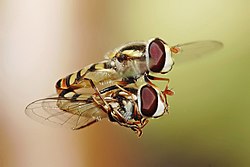Sexual

Sexual reproduction is a biological process that creates a new organism by combining the genetic material of two organisms in a process that starts with meiosis, a specialized type of cell division. Each of two parent organisms contributes half of the offspring's genetic makeup by creating haploid gametes. Most organisms form two different types of gametes. In these anisogamous species, the two sexes are referred to as male (producing sperm or microspores) and female (producing ova or megaspores). In isogamous species, the gametes are similar or identical in form (isogametes), but may have separable properties and then may be given other different names (see isogamy). For example, in the green alga, Chlamydomonas reinhardtii, there are so-called "plus" and "minus" gametes. A few types of organisms, such as many fungi and the ciliate Paramecium aurelia, have more than two "sexes", called syngens. Most animals (including humans) and plants reproduce sexually. Sexually reproducing organisms have different sets of genes for every trait (called alleles). Offspring inherit one allele for each trait from each parent. Thus, offspring have a combination of the parents' genes. It is believed that "the masking of deleterious alleles favors the evolution of a dominant diploid phase in organisms that alternate between haploid and diploid phases" where recombination occurs freely.
Bryophytes reproduce sexually, but the larger and commonly-seen organisms are haploid and produce gametes. The gametes fuse to form a zygote which develops into a sporangium, which in turn produces haploid spores. The diploid stage is relatively small and short-lived compared to the haploid stage, i.e. haploid dominance. The advantage of diploidy, heterosis, only exists in the diploid life generation. Bryophytes retain sexual reproduction despite the fact that the haploid stage does not benefit from heterosis. This may be an indication that the sexual reproduction has advantages other than heterosis, such as genetic recombination between members of the species, allowing the expression of a wider range of traits and thus making the population more able to survive environmental variation.
Allogamy
Allogamy is the fertilization of the combination of gametes from two parents, generally the ovum from one individual with the spermatozoa of another. (In isogamous species, the two gametes will not be defined as either sperm or ovum.)
Autogamy
Self-fertilization, also known as autogamy, occurs in hermaphroditic organisms where the two gametes fused in fertilization come from the same individual, e.g., many vascular plants, some foraminiferans, some ciliates. The term "autogamy" is sometimes substituted for autogamous pollination (not necessarily leading to successful fertilization) and describes self-pollination within the same flower, distinguished from geitonogamous pollination, transfer of pollen to a different flower on the same flowering plant, or within a single monoecious Gymnosperm plant.
Mitosis and meiosis
Mitosis and meiosis are types of cell division. Mitosis occurs in somatic cells, while meiosis occurs in gametes.
Mitosis The resultant number of cells in mitosis is twice the number of original cells. The number of chromosomes in the offspring cells is the same as that of the parent cell.
Meiosis The resultant number of cells is four times the number of original cells. This results in cells with half the number of chromosomes present in the parent cell. A diploid cell duplicates itself, then undergoes two divisions (tetraploid to diploid to haploid), in the process forming four haploid cells. This process occurs in two phases, meiosis I and meiosis II.
Comments
Post a Comment